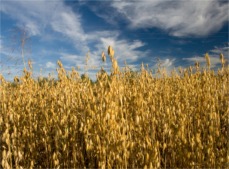Oats

The English lexicographer Samuel Johnson in his famous dictionary of 1755 defined the oat as "a grain which, in England, is generally given to horses, but in Scotland supports the people". Since that time, the nutritional value of oats to the human population has been generally recognised and there are many farmers who favour it over barley for animal feed. It is said that a diet consisting largely of oats and herrings was responsible for producing the great scientists and inventors from Scotland in the nineteenth century.
Oats are not too difficult to grow and do well on land that would not easily support a wheat crop. They will tolerate pH levels between 6 and 7 and also yield similar tonnages to wheat and are a good crop in rotation; a useful substitute for sugar beet where that break crop is no longer an economic option. Crop rotation is coming back into fashion as farmers are seeing that the only beneficiaries of mono-cropping are the companies that make and sell herbicides and pesticides.
Like other cereals, the price of oats is subject to world market prices. Again, like wheat there are two distinct markets. The lower tier is for animal, mainly sheep, feed. The quality end of the market is for clean, dust-free, high hectolitre/bushel weight crops for human diet such as porridge or biscuits and for quality horse feed.
Field Science has consistent success with oat crops, which, in addition to NPK, require adequate micronutrients including magnesium, manganese, copper and zinc. Cereals also require a little sulphur, but not at the levels that current industry propaganda would have us believe. The big downside of the excessive use of sulphur in any food or feed crop is that it can drastically reduce plant uptake of another vital nutrient - selenium. It is particularly important to know this if the crop is to be used to feed your own stock!
The result of this attention to detail has been clean crops of good colour with very high bushel weights and superb straw, ensuring revenues at the top end of the market range in any year.
The Dressing Process
Field Science tailored mineral dressings are always based on detailed soil analysis of the field to be treated. A member of our technical team will visit your farm to discuss and identify where we can help. Soil samples are then taken and the tailored dressings are based on the independent laboratory’s results.
The dressings are available in two concentrations:
1 Year Dressing is cheaper per acre and is essential if the soil is ploughed after harvest or if the soil is extremely sandy.
Full Dressing is formulated to last for 2 - 3 seasons from application (subject to nutrient retention qualities of the field). This dressing is cheaper in the long run given the longevity and the cost of application only once every 2 - 3 years but the soil must not be ploughed during this time. Min-tillage is perfectly acceptable.
The best time for application is just after emergence in the case of spring oats and February/March for winter sown oats. This avoids any particularly wet weather.
The application rate is usually 25kg per hectare (10kg/ac) and the most effective method of application is to use an electric spinner (slug-pelleter) on a quad bike. The dressings are packed in 25kg bags, clearly labelled with the farm details, field name, application rate and bag weight.
